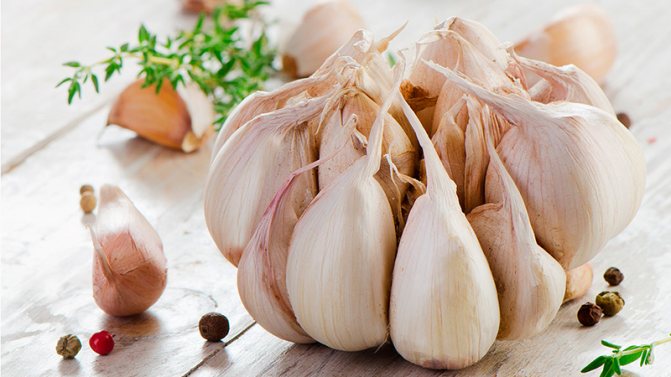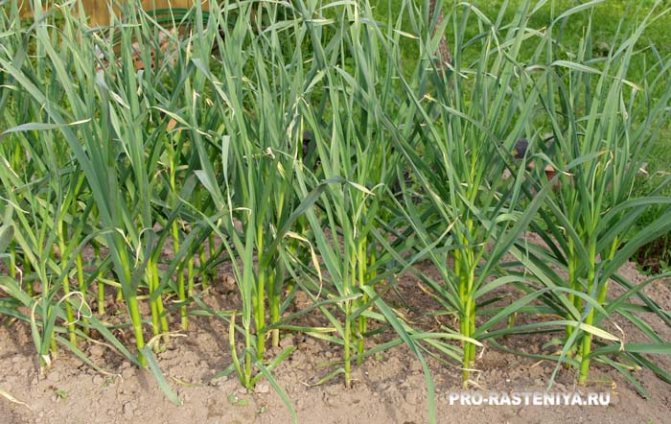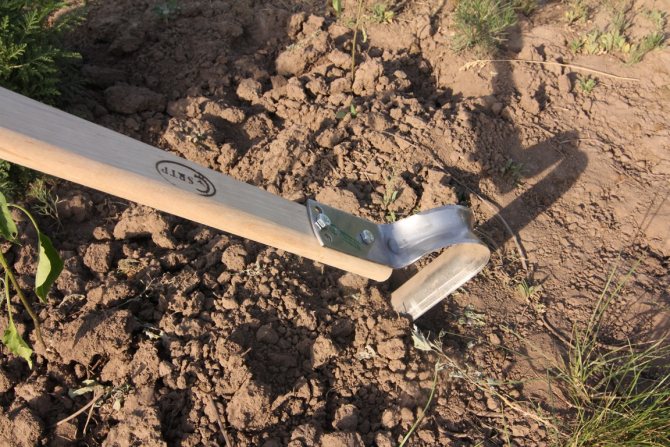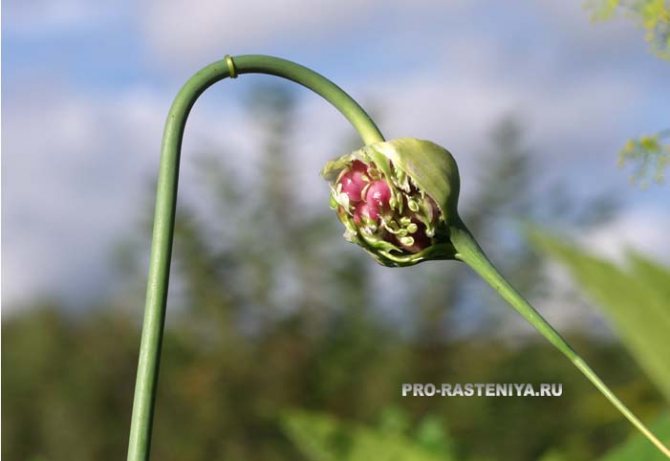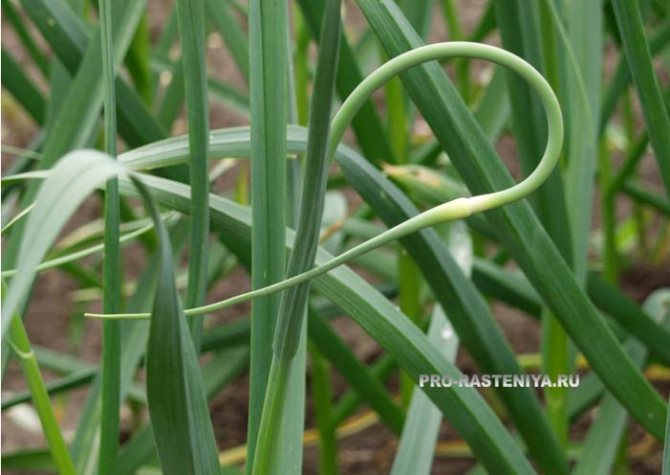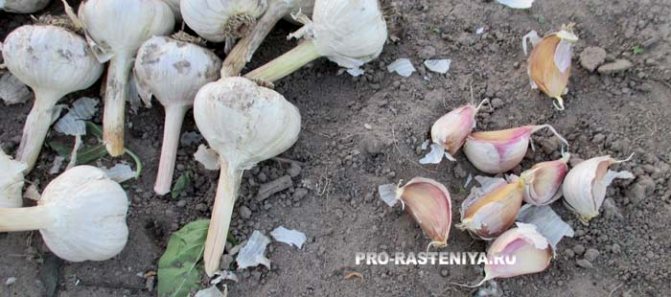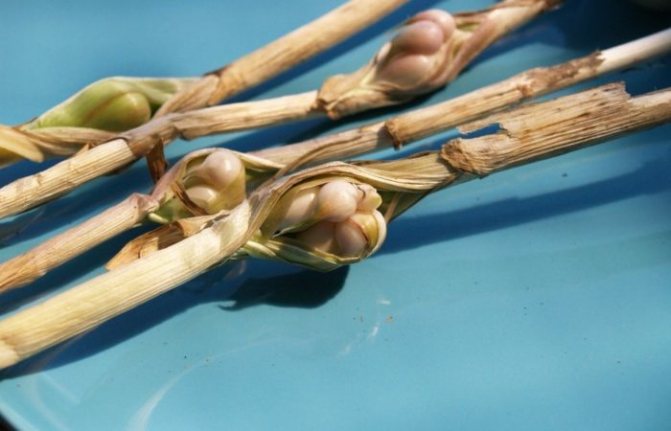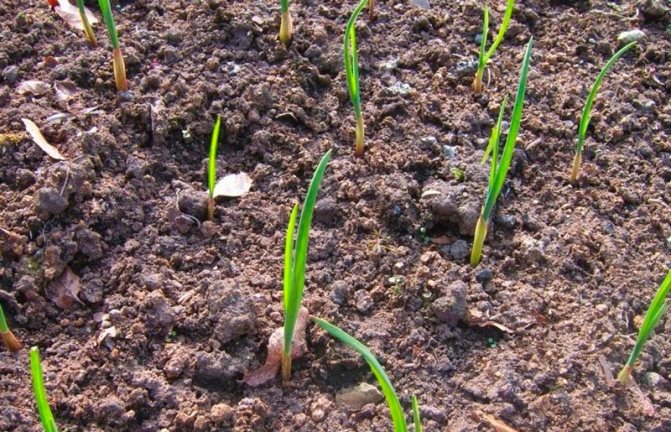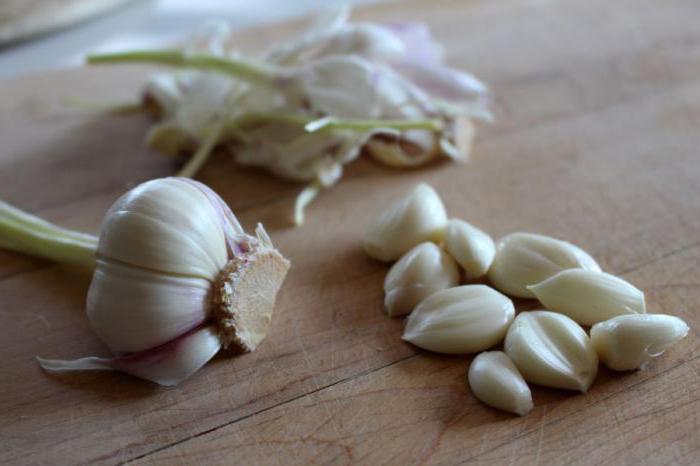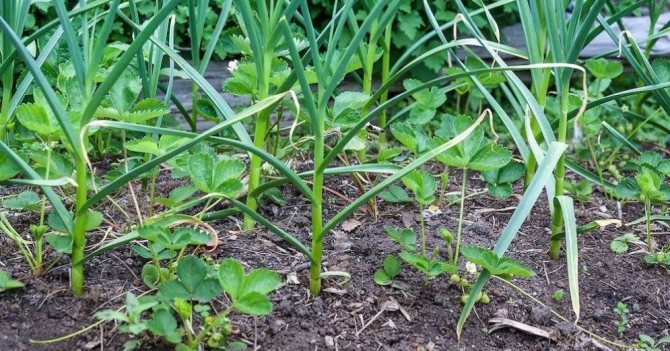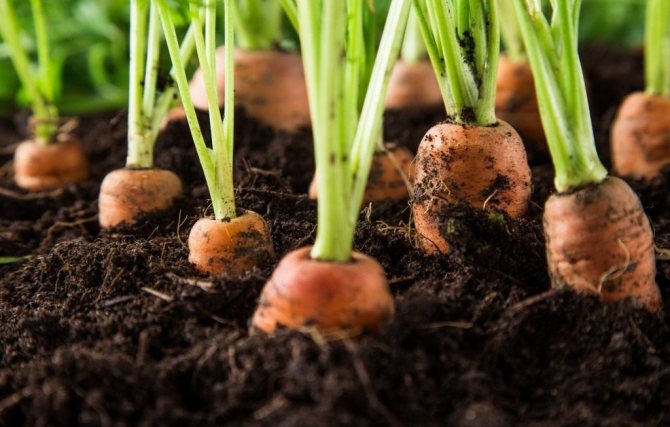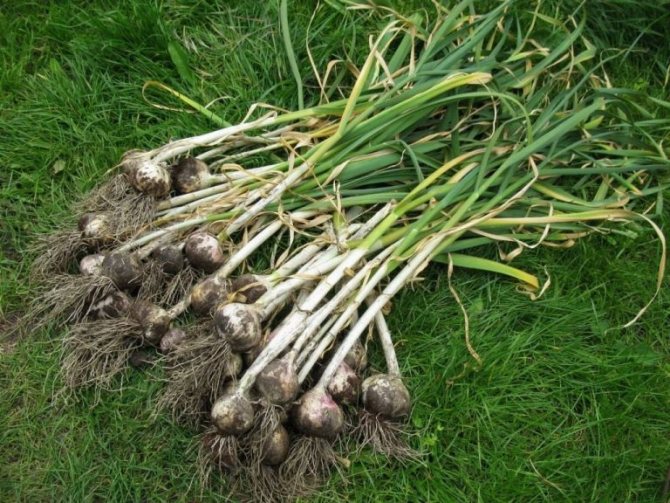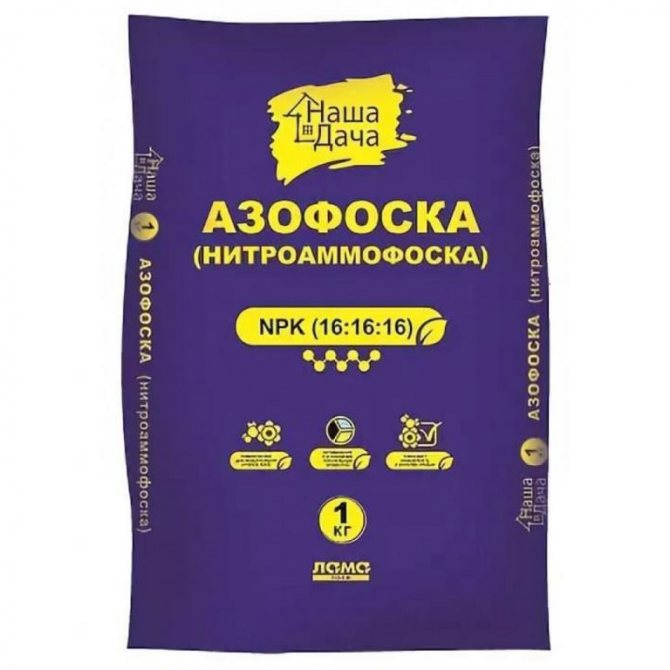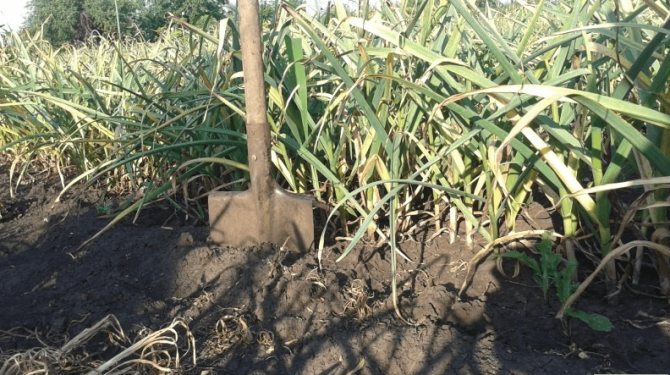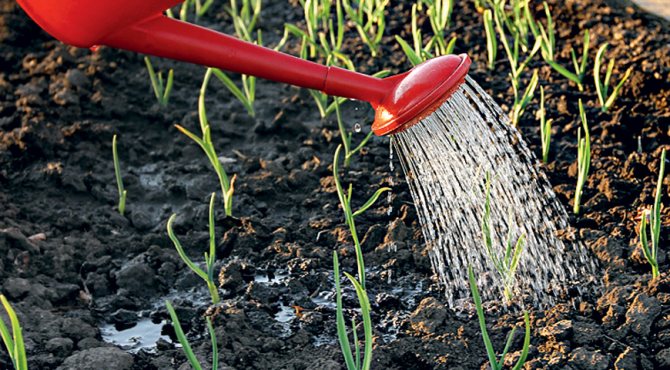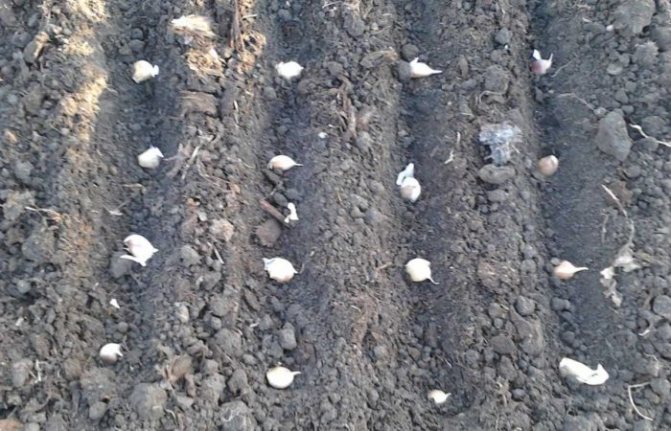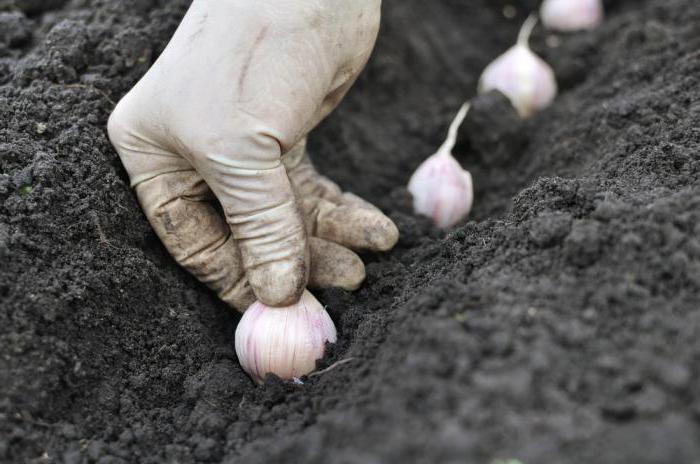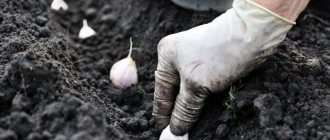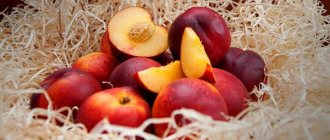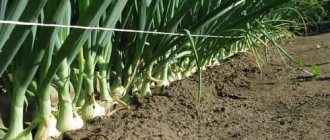Garlic is a culture cultivated for many years on the lands of Russian summer residents, which is as popular as onions. The specific taste of this vegetable determines its widespread use, because only one clove of garlic can add incredible appetizing and spiciness to any dish. In addition, the benefits of garlic for the body are undeniable, eating it raw allows the immune system to more effectively fight viral diseases and other ailments. There are a large number of varieties of this culture, but most of all Russians love spring garlic. We will consider the cultivation and care of this vegetable in this article.
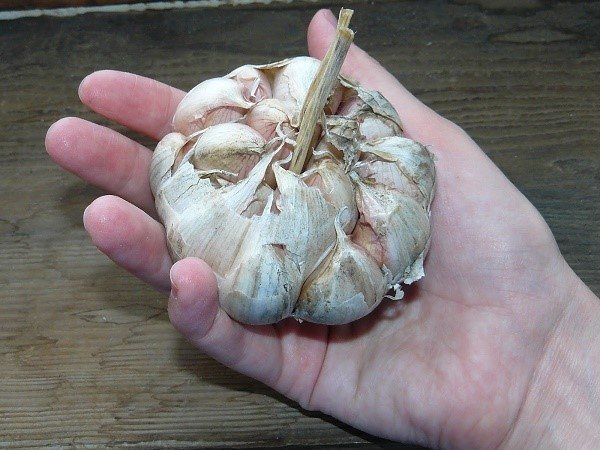
Spring garlic: growing and care
The main differences between winter and spring garlic
Winter garlic shoots, that is, during growth, it releases the so-called arrow. It is very frost resistant. It is planted in late autumn. After winter, by the next season, we get big full heads. This is a high-yielding type of garlic. It also differs in that its heads are stronger, of better quality, and there are fewer teeth in them.
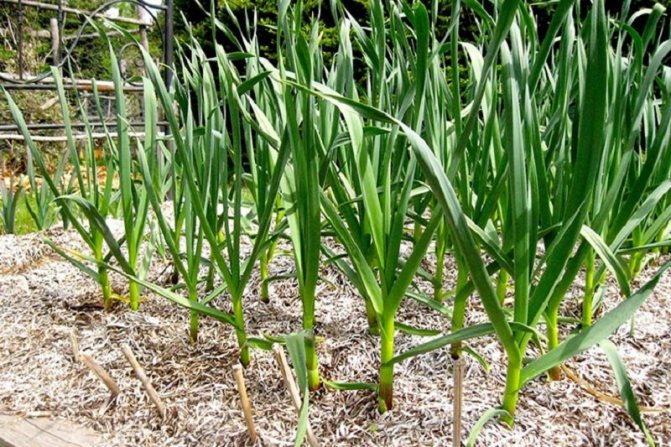

Reproduction of garlic requires certain skills and knowledge.
Spring garlic does not give an arrow. It is planted in the spring. Its main advantage is that it can be stored for a long time. However, it does not yield such a rich harvest. Common features and differences between spring and winter garlic:
| Spring garlic | Winter garlic |
| Small onions. Barren. Spring varieties do not shoot. | Large onions. High-yielding. Winter varieties are shooted and have air bulbs. With their help, garlic multiplies. |
| Spring garlic is planted in open ground in early spring. Spring frosts tolerate well. | Winter garlic is planted outdoors in the fall. Frost-resistant species. |
| An onion contains up to 30 cloves. | The head contains less than ten teeth. |
| The teeth are arranged in a spiral (the closer they are to the center, the smaller in size). | The teeth are arranged in one row around the main shaft. |
| Keeps perfectly. | Not stored for long. |
| Propagated by planting cloves. | Propagated by bulbs and cloves. |
| The growing season is short | The growing season is long. |
Pros and cons
There are advantages and disadvantages to one-piece head planting. In the gardeners' reviews, the following advantages are noted:
- Saving space: the yield from one site is as many times as there are, on average, the cloves in the planted heads;
- Save time: plant with heads much faster than with teeth.
- Aftercare is easier, easier: the same number of bulbs, planted according to the traditional method, will require much more physical and time costs.
Summer residents who have tried the family growing method note only one drawback. The heads, which grow tightly together, are smaller than the bulbs of the same variety, planted with separate cloves. But the resulting medium-sized garlic is a decent result at minimal cost, judging by the photo.
Therefore, family cultivation technology remains popular.
Garlic propagation methods
Garlic reproduces vegetatively. Winter view - also by means of seeds. Only the cloves of the heads are selected from spring garlic for planting. Winter crops are bred both with cloves and seeds from air bulbs (the so-called bulbs).In the latter case, it takes two years to get a harvest of large, beautiful and healthy heads.
In the first year, the aerial bulb produces a small set-head, which consists of a single clove. It has the same properties as complete garlic. However, only next year an ordinary head with many teeth will grow from the set. Winter garlic is often preferred by ordinary gardeners because of its high yield.
Preparation
2 months before planting in the ground, transfer the seed to a colder room (from 0 to + 4 ° C) - for example, a basement, refrigerator. This is done to "harden" the air bulbs so that they quickly and successfully get used to the soil.
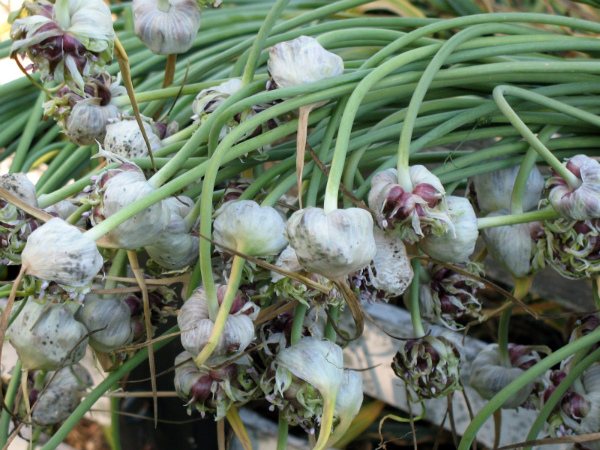

Before planting, it is necessary to hatch from the inflorescences and select healthy large bulbs, ideally with a diameter of 3-5 mm or more. Experienced gardeners have noticed that airflow with a diameter of 5 mm or more gives a high-quality one-tooth.
The finer the planting material, the lower the crop yield.
Small seeds (2-3 mm) are sown in a separate area. They will produce a custom one-tooth that can be re-planted in the fall to get a larger one. Very small bulbs are not suitable for planting - they are thrown away.
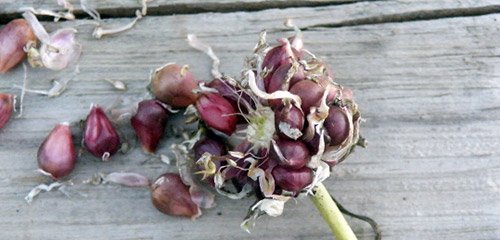

Propagation of garlic with air bulbs
To obtain mature bulbs, wait until the garlic inflorescences are fully formed and the film covering them cracks. Then the inflorescences are cut off along with the arrows at a height of 20-30 centimeters and dried properly. In the case when the bulbs are planned to be planted in the spring, then they should be stored in a dried form in inflorescences. If in the fall, air bulbs-bulbs must be dried for 30-40 days and only then planted.
Garlic planted from bulbs will ripen after a longer period than ordinary garlic, but it will be of better quality, and its grade will remain. A full-fledged head with many teeth will be received only after 2-3 years. In the first year, an onion ripens from one clove weighing 0.5-5 grams - this is a set, from which a single-clove bulb will also grow in the second year, but already a little larger. It is also planted and the next year, finally, they get a full-fledged head.
Thus, garlic must go through 4 stages:
- air onion-bulb,
- one-toothed onion set,
- large onion set, consisting of one clove,
- full head.
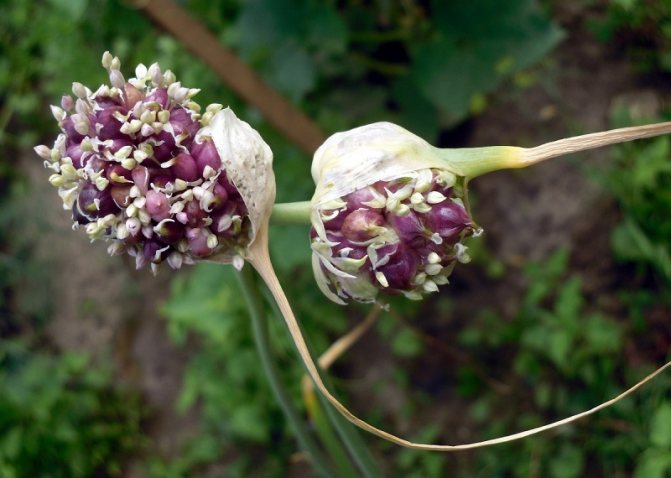

To propagate garlic with arrows, they are also called bulbs, you need to wait until the plant fully rises, and an arrow appears at the top, which will grow into a bulb.
Description of culture
Outwardly, garlic resembles an onion in shape, slightly flattened at the edges, however, the structure of this vegetable is much more complex. So, inside the "onion" is divided into several so-called sinuses, inside each of which can form, depending on the variety, from 2 to 50 teeth.
The teeth themselves are oblong and can be of absolutely any size. Their color is usually:
- white;
- yellowish.
However, in addition to the traditional shades of the vegetable, there may be cloves colored in:
- pinkish tint;
- deep lilac color.
The leaves of the spring garlic variety look traditional:
- they are narrow;
- have the shape of a lancet;
- stretched up;
- sharp endings.
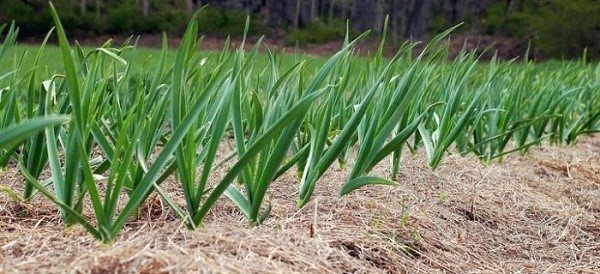

Spring garlic leaves are also readily used for food, as they are very juicy and have a mild taste.
The width of such a leaf of garlic usually reaches a centimeter, but in height it sometimes grows up to a meter. The stem of the culture has a generally complex structure, so subsequent leaves grow from the sinuses of the previous ones.
This plant also throws out an arrow, which is often eaten fried. The height of the arrow is 70-140 centimeters.The end of the arrow is a curved tail, crowned with an inflorescence, then transforming into a box containing a small number of seeds.
Benefits of air bulb propagation
- When using this method, it is possible to more quickly obtain valuable varieties of crops.
- Very healthy and high-quality heads grow from the air bulbs.
- This method makes it possible to avoid the stem nematode, an active insect pest of the crop, which affects the bottom without penetrating the inflorescence, which allows the bulbs to remain intact and unharmed, and intact heads grow from them.
Bulb garlic can be grown in two ways:
- with a transplant: the sevok is planted in the same year when it was dug - in the fall or next spring;
- the sevok remains in the soil for the winter. And next year, a large head is obtained from it.
Growing bulbs
We select large 4-clove garlic heads and plant them according to the winter type in due time.
We are waiting for the shooters and characteristic round inflorescences to appear at the top of the arrow. When the inflorescence is fully formed or the film bursts on it, the bulbs are almost ripe. Now they can be harvested for seeds.
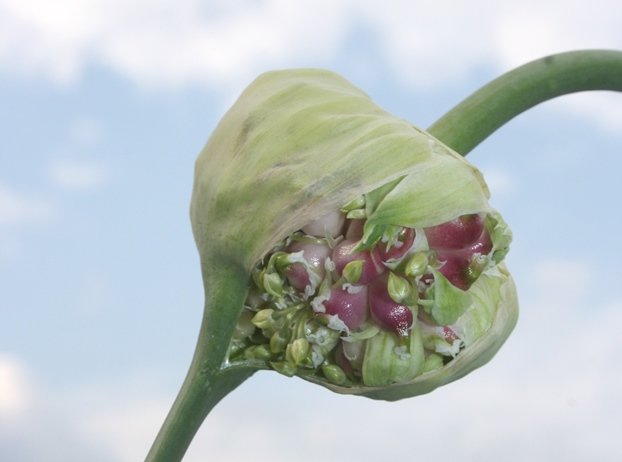

Cut off the arrows 30-35 cm long, put on a tarp and leave for at least 30-40 days in a dark, dry room with a temperature of + 18-20 ° C.
For better preservation of nodules, leave them in the inflorescences for the entire storage period.
From 1 hectare, you can get up to 10-15 centners of airy bulb seeds.
Reproduction of garlic from cloves
To cultivate garlic without any problems, you need to choose the right place for planting. Due to the fact that spring garlic is planted in spring, and winter garlic in autumn, climatic conditions must be taken into account when choosing a place and type. For example, in regions with a cold climate, the winter species is predominantly grown, and in warm ones, the spring species.
Tip # 1. Winter garlic is resistant to low temperatures, however, it is necessary to calculate the planting time in such a way that the cloves take root, but the leaves are not released.
It is planted about 3 weeks before the soil begins to freeze. Planting of spring garlic occurs in the spring, when the soil has already been prepared for this. The garlic bulbs must be divided into cloves. For planting, the best quality, large teeth are used. Garlic should be planted in rows every 25 centimeters. In one row, the distance between the teeth is 8-10 centimeters.
Cloves of winter garlic should be planted in the soil to a depth of 7 centimeters, spring garlic - 5 centimeters. The distance in one row between the bulbs is 2 centimeters. The space between the rows is approximately 10 centimeters. Winter garlic should be covered with a layer of humus or peat, and branches on top. You cannot plant garlic in one place for more than two years in a row, otherwise it will not grow healthy and strong. It is advisable to grow it every year in different beds.
Where garlic is sown, no potatoes or onions should be grown earlier. You can sow garlic after pumpkin seeds, cucumbers, cabbage, beets, legumes. Garlic beds should be well lit. They can be located near berry bushes (strawberries, black currants, gooseberries, raspberries), vegetables (cucumbers, carrots, potatoes), flowers (roses, tulips, gladioli). In this case, the garlic will not become infected with black spot.
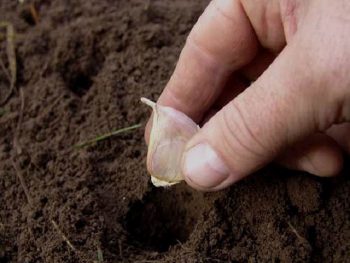

Many gardeners and gardeners favor the chive propagation method more, as it works well for both types of garlic and works great for large yields.
Airborne landing
Garlic with air bulbs can be planted 2 times a year:
- winter - 35-45 days before the start of frost (between September 20 and October 10);
- spring - in early spring, as soon as planting can begin.
The method of planting air nodules in a private garden is a standard lowercase, between the lines (rows) the distance should be 20-25 cm.The ideal seeding ratio is 40-50 bulbs per running meter.
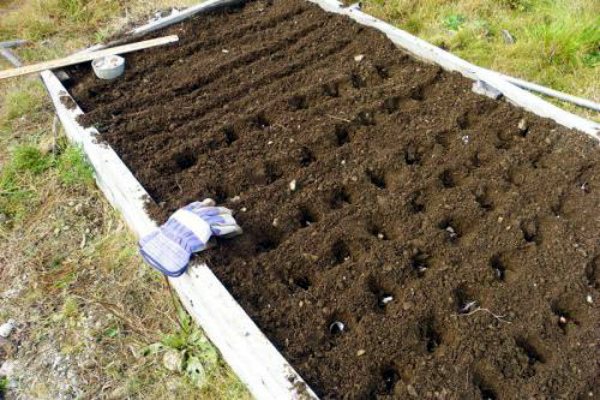

Embedment depth:
- for nodules with a diameter greater than 5 mm - 4-5 cm;
- for nodules 3-5 mm - 3 cm.
Seeding material consumption:
- for nodules with a diameter greater than 5 mm - 300-500 kg / ha;
- for nodules 3-5 mm - 200 kg / ha.
After planting, mulch the soil with humus, sawdust or peat 2-3 cm thick.
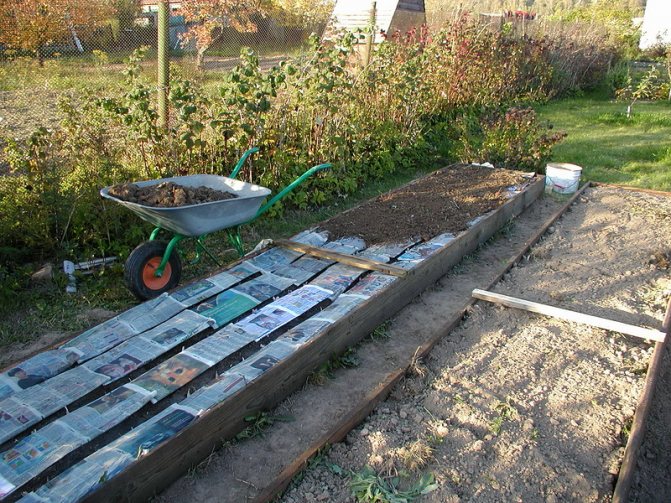

It is interesting: there is another curious way of planting garlic seeds in autumn:
- Cover the prepared bed with 1-2 layers of wet newspaper.
- Punch rows of small holes in the newspapers.
- Plant the seeds in the holes, sprinkle with humus.
- Place a thin layer of earth or sand on top of the newspapers.
- Add sawdust or peat mulch.
The method suppresses the growth of perennial weeds, the roots of which overwinter in the soil, saving time and effort in weeding.
How to care for garlic
In order to get a good, high-quality harvest, it is necessary to follow agricultural techniques in caring for garlic, which means:
- water,
- mulch,
- loosen,
- weed,
- feed.
Plants should be watered once a week. For 1 sq. m, 10 liters of water are poured. Later it is reduced to 8-6 liters, otherwise the heads will start to rot. In rainy seasons, the culture does not need to be watered at all. Watering is stopped 2 weeks before harvesting. Most of all, garlic needs moisture during the early growing season. The soil must be loosened after each watering to a depth of 2-3 centimeters. If mulch is used, loosening can be dispensed with.
Tip # 2. For winter garlic, more abundant watering is assumed. In winter, the beds with it are covered with a snow layer. For a good harvest, it is recommended to pluck the arrows when they reach 5-8 centimeters.
Garlic growing in the garden must be nourished. The first feeding is carried out with several leaves. A tablespoon of urea must be diluted in a bucket of water. Fertilization rate - 5l / 1 sq. m. Then you can use a solution of manure (1:10) and poultry droppings (1:12). The second feeding is carried out after 2 weeks. It consists of a solution of a teaspoon of carbamide, a tablespoon of potassium sulfate and a tablespoon of double superphosphate. An ash solution consisting of 10 liters of water and 200 grams of ash can be used.
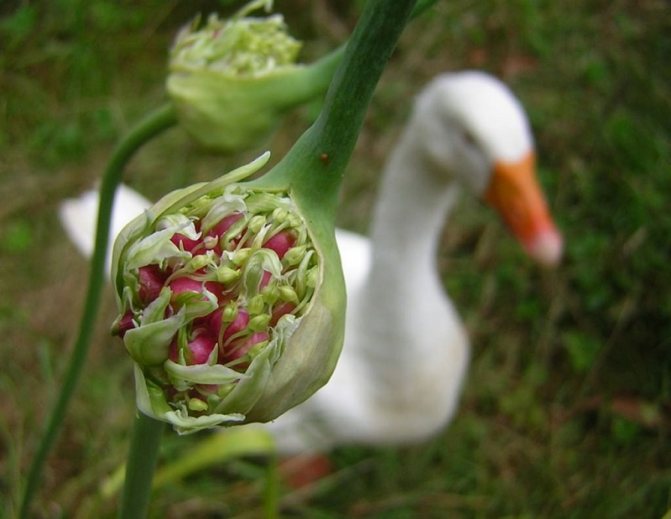

Bulb, with the help of which in the future it will be possible to carry out the process of reproduction of garlic.
The third top dressing is applied when the garlic bulbs and arrows form - at the end of June. To feed the plants, a tablespoon of potassium sulfate and two tablespoons of double superphosphate are dissolved in a bucket. Fertilizers are combined with watering. Sprinkle the plantings well with wood ash (1 glass per 1 sq. M) between dressings. When mulching, it is best to use straw, which is used to cover the beds when the seedling height reaches 10-15 centimeters.
Types and varieties
To date, a large number of different varieties of garlic have been bred. But they are all divided into two types, namely:
- winter (planted in open ground with the arrival of autumn);
- spring (suitable for growing in spring).
Also, garlic is divided into two more large groups - shooting and non-shooting varieties. In the first group, instead of seeds, one-toothed bulbs develop, which are used for planting crops in the ground. Often, only winter types of garlic are allowed to shoot, while in spring garlic this feature is extremely rare.
Large, large garlic can be grown from winter varieties. However, such a culture will be stored very little. Almost in the last month of winter, the vegetable will begin to deteriorate.
As for summer garlic, the bulb heads don't grow as gigantic, but the shelf life can be up to 2 years.
In order to grow a good harvest of garlic without problems and hassle, experienced gardeners advise planting two types of vegetables in the garden at once.Despite the fact that the spring crop is in second place in terms of yield and head size, it still has a longer shelf life than the winter crop. In terms of taste, both types of garlic are exactly the same.
Winter garlic varieties are grown on a large industrial scale for sale. The spring vegetable is cultivated for long-term use.
At the dacha, you can grow different varieties of vegetables. For example, most farmers are engaged in the cultivation of Indian and Chinese garlic (variety "solo"), they also grow the variety "Rockambol" (such garlic is called "elephant" or giant).
If you want to grow garlic with a fist-sized head, it is advisable to use large-fruited crop varieties. For such purposes, it is best to take "rockambol". It is worth noting that only when planting seeds for the winter will the head size be large. If you grow the vegetable as a spring crop, the bulbs will be small.
Many people are interested in the question: "Is it profitable to grow garlic for sale?" Such a business, of course, does not require large expenses, however, it usually does not bring high profits. The main thing is to regularly take care of the spice, as well as plant high-quality seeds, which will give a good harvest in the future. In addition, farmers and outdoor vegetable growers argue that such a business can be risky and difficult to organize. This is due to the fact that high-quality seed is not cheap, cultivation also depends on climatic conditions. As a result, farmers often grow garlic in a greenhouse.
Mistakes when planting garlic
- The construction of a culture in the same place for several years in a row. The arrangement of the beds should be changed annually.
- The soil on the ridges should be fertilized with humus. It is good to add chalk to it before planting. Garlic does not grow well in acidic soils.
- Poor quality planting material. Imported garlic is not suitable for planting, as it is processed with special solutions.
- If during cultivation the stem of the plant has partially dried out, watering and feeding cannot be carried out.
- Poorly processed planting material.
- Late loosening in spring. If there is not enough oxygen in the soil, garlic will begin to turn yellow early. The soil must be loosened as soon as the snow melts.
- The garlic is planted shallowly. Landing should be made at least half a shovel bayonet.
- The soil in the beds is not mulched.
- Very tight fit.
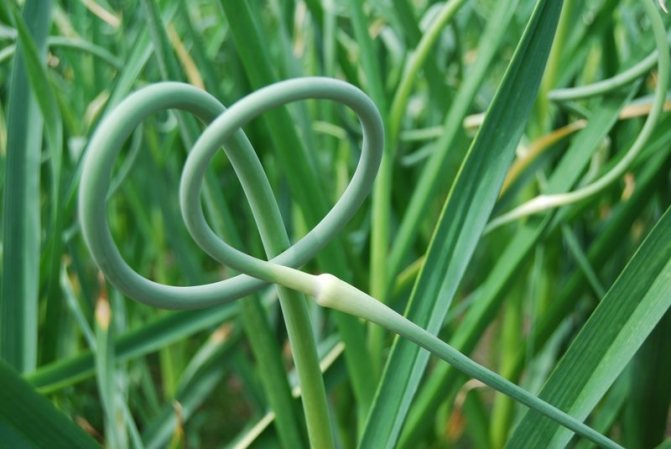

The bulbs are obtained from such arrows, as shown in the photo, after the arrow is ripe, if you do not cut it off, a round bulb will appear for propagation.
Harvesting one-toothed
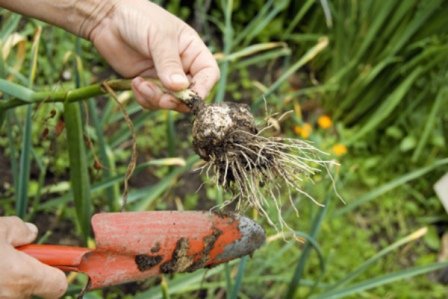

One clove of garlic is harvested when the tips of the leaves begin to turn yellow and the feathers begin to fall. It is dangerous to be late with harvesting - the leaves dry out quickly, and the head goes into the ground, and it will be difficult to choose it. Gardeners say that it is better to underexpose garlic in the ground than to overexpose - ripening can be completed even after uprooting.
The approximate harvesting time for the one-tooth is mid-late July. To check, remove a couple of heads from the soil - they must be firm, well-developed.
It is better to dig the garlic with a pitchfork. Pry a clod of earth with a bulb, pick it out of the soil with your hand. Spread the dug out plants along the length of the bed for several hours without cutting off the leaves, then dry it in the attic or under a canopy.
Garlic left for a long time in the sun "glazes", so do not throw it in the garden in the heat.
After drying the crop, crush the stem, cut the roots and store it in a dry, dark place with good ventilation.
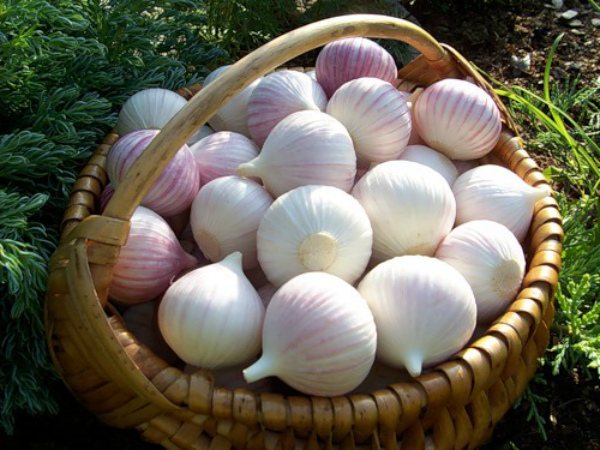

When summer garlic is planted
Spring varieties are planted in the soil in mid-April - early May. At this time, the soil is still quite moist, and the frost is no longer so strong. The culture does not like dry and warm soil, so it is more rational to plant it as soon as the snow melts. The soil temperature at this time warms up to 5-7 ºС.
Such conditions in the Moscow region begin from the 20th of April, in the southern regions earlier by 2-3 weeks. And in the northern ones, on the contrary, it is better to plant 2-3 weeks later, that is, in the last days of April - early May. At the same time, the temperature of growth and development is different.
- And at the initial stage of vegetation it is enough - 10-15 ° С;
- During the formation of cloves - 15-20 ºС;
- For ripening, a temperature of 20-25 ºС is required.
When the weather is already warm and the ground warms up more, the plant stops developing, and the bulb stops forming.
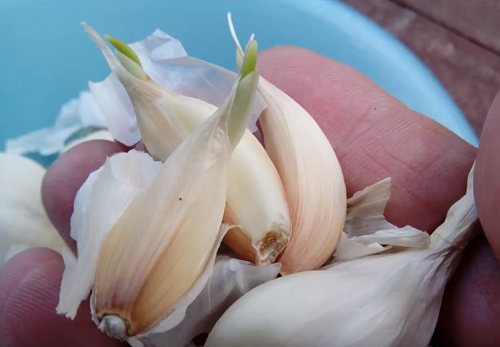

Preparing the material
For planting, we select exceptionally large teeth that do not have traces of disease, rot and mechanical damage. Discard small ones - large ones will not grow out of them. You should also abandon bulbs with 3 or less prongs - this is a degenerating plant.
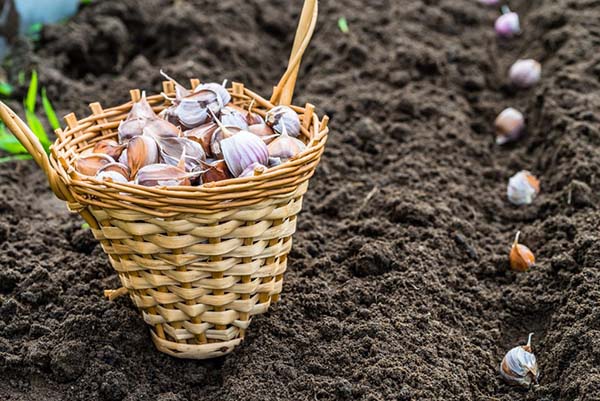

Some people practice soaking the teeth before planting in salted water and then washing them with a solution of copper sulfate (sometimes in conjunction with watering with a solution of the intended landing site). Such disinfection makes sense if there is not enough garlic for planting. At the same time, no one will give guarantees of the survival of plants, but a safety net will not hurt.
Landing in open ground
How to plant spring garlic? In the spring, the bed is loosened, they are allowed to dry out a little. If the soil is too damp, rot may develop. Between the teeth it is tedious to make a distance of about 8 cm to leave everyone enough space for development. A distance of at least 25 cm is left between the rows. It is not worth planting the cloves very deeply, it is better if they are at a distance of 2 cm from the top of the cloves.
After placing in the ground, the seeds are sprinkled with earth, then mulched with peat. This delays the growth of weeds, retains moisture, prevents crust formation, eliminates the need to loosen the soil. A layer of straw or hay can be used as mulch. It will exclude overheating of the ground surface, retain moisture in the first layer, where the roots are located.
Large teeth should be planted separately from small ones. You can completely abandon planting small cloves, since small heads of garlic will grow from them. Smaller teeth are sometimes planted in shady places to get green, the leaves stay juicy, green, tender longer.
Modern high-yield varieties of garlic
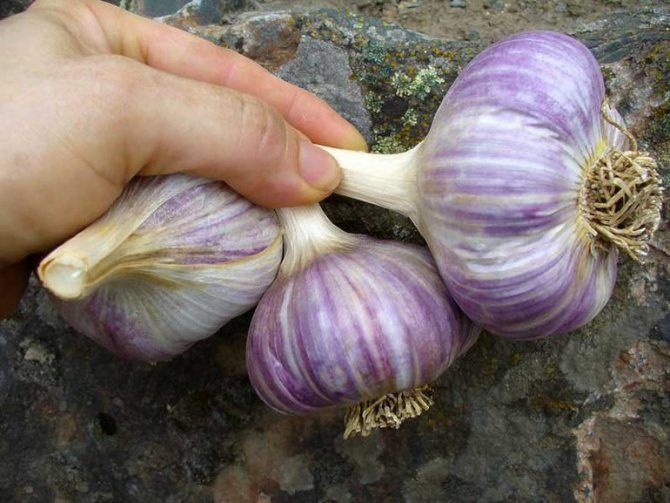

Aleisky. Mid-season variety (from leaves to wilting - 80 days). Stem up to 21 cm long. Leaves - up to 32 cm long, up to 1.3 cm wide (up to 11 pieces). The head weighs up to 25 g and has up to 15 teeth. Vaklanovsky. Late-ripening winter variety (peri-ration of vegetation - 95-120 days). The head - weighing up to 62 g, has up to 5 teeth. Leaves up to 60 cm long, up to 3.5 cm wide. Arrow (arrow up to 1.8 m long). Productivity - up to 0.6 kg / m2. Weakly resistant to powdery mildew, fusarium. Gafurinsky. The growing season is 100-110 days. Plant up to 50 cm high. Leaves - light green, up to 27 cm long, up to 1.8 cm wide. Stem up to 15 cm long, up to 12 mm in diameter. The head - weighing up to 30 g, has up to 18 teeth. Productivity - up to 0.5 kg / m2. Gribovsky about. Early ripening variety (growing season - 95-100 days). The head is white, large, weighing up to 100 g. The teeth are large, up to 12 pcs. in the head. Arrows. Can be planted before winter and spring. Kiseleva. Early ripening variety. The head is white, large, weighing up to 80 g. The teeth are very large, no more than 5 pieces in the head. Arrows. It is good to plant before winter. Ukrainian white. The head is white, medium in size. The denticles are small. Does not shoot. They are planted before winter and spring.
How to store garlic in the winter at home to keep it dry
It is better to process the main part of the crop immediately and make preparations for the winter. The rest is stored until spring in a room where in winter it keeps a rather low, but positive temperature with low air humidity. The prepared heads are placed in boxes, baskets or mesh bags, they can be woven into braids.
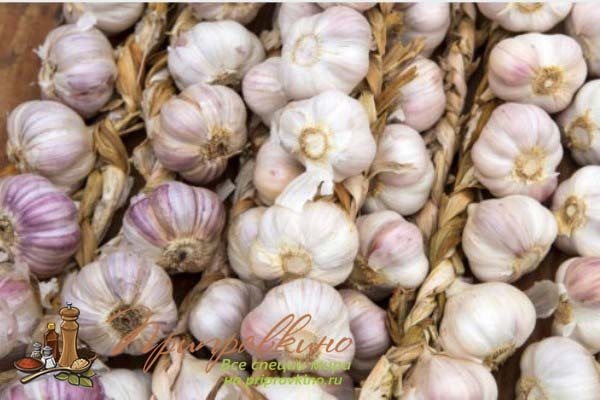

At a temperature of 1-3 C, they will remain juicy and fresh for a long time, and until spring they will not germinate or dry out.
Experienced growers know how to properly store garlic at home at room temperature. There are two reliable methods suitable for a city apartment:
- Well-dried heads of garlic are folded into a canvas bag, tied and put into a plastic bag, leaving it open.
- Another method - you need to take a jar or a saucepan, pour a 2-3 cm layer of salt on the bottom, then put the heads of garlic and fill it with salt again, etc. The top row must be covered with salt, but it must not be soggy.
Stimulating the growth of seed
Sometimes, to increase yields and accelerate the ripening process, roots are grown on the teeth. Garlic is kept for a couple of hours in water or in a weak solution of manganese, after which the seeds are wrapped in a damp cloth, then placed in a bag and sent to a refrigerator or cellar for several days. In a damp and cool room, the roots begin to grow back. Sprouted teeth should be planted very carefully so as not to injure.
There is another way to stimulate the development of culture. Before planting, you can soak the teeth in a slightly warm solution of nitroammofoska (5 g is put on 10 liters of water).
Features of growing garlic in the regions
Since garlic is a frost-resistant crop, it is grown in almost all regions. The methods and methods of cultivation are the same. The difference exists only in the specific calendar dates for planting and harvesting, depending on local climatic conditions. When you start growing garlic, you need to know that there is one important feature inherent in this culture. Over the years of cultivating garlic in a certain area, it adapts to its characteristics and, as it were, gets used to it, adapts to them.... If you subsequently take seed, for example, from the Moscow region and plant it in Ukraine, then the gardener may well be disappointed. The size of the heads, their quality and yield can be significantly lower than when grown in a familiar region. Therefore, when purchasing seed material in an online store, you need to be prepared for the fact that the expectations of its properties, declared by the seller, may not come true. It is best to use local tried and tested varieties.
Cleaning and storage
The shelf life of spring garlic depends on how correctly the harvest is harvested and prepared for storage.
Cleaning
To understand when to harvest spring garlic, you need to monitor the condition of the leaves. In a mature culture, they turn yellow and wither. As a rule, spring garlic is harvested in the second half of September. In the southern regions, the culture is dug up earlier than in the north-west of the country. You can speed up the ripening process of the culture. To do this, each leaf is tied in a knot. Leaves should be tied in weak knots. This action is performed 30 days before harvest.
Dig the crop only in sunny weather. During cleaning, they act carefully: mechanical damage to the teeth negatively affects their keeping quality. Harvesting from the garden immediately after harvesting is not worth it. It should dry in the open air for 40-60 minutes. If the soil is wet, spread the crop on a tarp.
Harvesting can be done manually or using special equipment.
Storage
After harvesting, the garlic is sent to the attic or garage to dry. You can dry ripe heads in the fresh air, but they should be under a canopy. Exposure to direct sunlight negatively affects the shelf life of the crop. The heads can be dried on nets or suspended. If drying is carried out in a suspended state, then the heads are tied in bundles of 4-5 pieces.
After finishing the drying of the crop, we cut off the dried leaves and weave the heads into braids.To preserve the harvest at home until spring, the leaves are cut at a distance of 6-8 cm from the neck. You can store crops in linen bags or cardboard boxes, but braided garlic lasts longer than bagged or boxed garlic.
When to plant
The snow has melted, and the soil has not yet warmed up enough - which means that you need to plant garlic in the middle of spring. Such a period in the middle lane falls on the end of April - the first ten days of May. If you are late with planting, the yield will decrease by 2 times.
A special feature is that the vegetable is planted when the temperature is still low on the street. The rapid growth of rhizomes in the planted cloves is observed at temperatures from +2 .. + 3 ° С, and the appearance of the first delicate leaf blades is expected at warming up to + 6 ° С.
Winter species care
After the seedlings are in the soil, they will need to be covered with a thick layer of leaves or straw. This will protect the heads of garlic from sudden changes in temperature during severe frosts up to a thaw. As a result, the bulbs will not freeze.
It is quite simple to care for the grown plant. The main thing is to do all the procedures on time.
With the arrival of spring, the mulching layer can be removed so that the earth can warm up with the sun's rays, thereby accelerating the growth of seedlings.
When the soil warms up and the first shoots of garlic grow, it is necessary to return a small layer of mulch to its original place in order to contain moisture and prevent the development of weeds.
If the soil is not too dry, it is not necessary to pour the garlic abundantly. The less liquid is used when watering, the richer the smell of the vegetable will be.
In the summer, winter and spring garlic give arrows that need to be disposed of, otherwise they will not allow the crop to grow normally.
Diseases
In the spring, it is important to provide the vegetable crop with proper care, otherwise it will be struck by an ailment.
The nature of the disease is determined by the appearance of the plant.
Fungal diseases
The most common diseases are fusarium, white rot, rust, neck rot, black and green mold. All of these diseases are caused by fungi. Fungal diseases can be determined by the appearance of the leaves. Yellow spots appear on them, which darken over time. The teeth either become watery and start to rot, or shrivel and dry out.
Treatment of these diseases is impossible - you have to destroy the affected plants. The main preventive measure is the observance of crop rotation and the use of good planting material. After sowing, diseased plants grow from the affected teeth.
Viral and bacterial diseases
These diseases are less common. Cloves damaged by bacterial diseases are poorly stored. Their bottoms rot or sores appear. The symptoms of viral diseases are slow growth, deformation and chloroticity of the leaves.
To treat the listed ailments, pesticides are used. The last processing is carried out 30 days before harvest. A preventive measure is the treatment of planting material with TMTD.
We plant and take care of
How to plant - in beds, rings or geometric patterns - does not matter. We maintain the distance between the teeth at least 10-15 cm, it should be planted to a depth of about two values of the clove (for example, if the tooth is 2 cm, then the layer of earth above it should be 4 cm). You should not apply pressure on the prong when landing, because growing roots can subsequently push it upward.
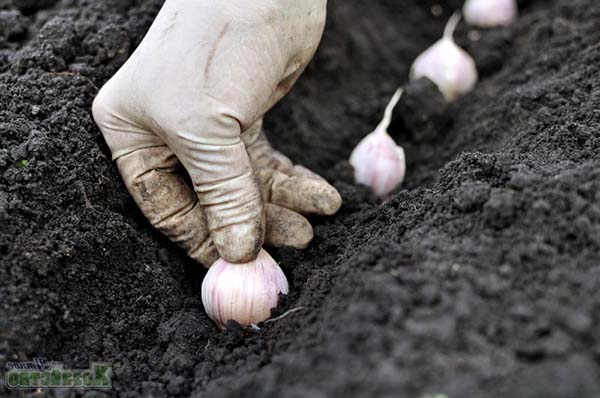

If there is a lot of snow in winter, then its cover will reliably protect crops from freezing. If not, then you should attend to a shelter of ordinary sawdust with a layer of 4-5 cm, if they are not there, then peat will replace them well. The debate about which garlic is better - spring or winter - never ceases between summer residents almost never.You have a great opportunity to find out for yourself.
Seat selection
Winter garlic is grown in all regions of the Russian Federation, including in the north. The culture is frost-resistant, therefore it survives winter temperatures safely.
Features of choosing a site for winter garlic:
- Good illumination.
- Waterlogged and waterlogged soils are not suitable - garlic blows out on them. Preference is given to elevations - so that the site is not flooded with melt or rainwater.
- Favorable predecessors are legumes, pumpkin seeds, greens.
- The best soils are fertile sandy loam and loam.
- The best neighbors are berry crops. Garlic is planted near raspberries, strawberries, gooseberries, as well as near flowers - it coexists well with roses, tulips, daffodils, gladioli.
What pests can you face?
The most dangerous diseases of winter garlic are rot and rust. Bacterial infections usually attack garlic during storage, and then penetrate the soil with the planting material. Table 2 shows common diseases of winter garlic and methods of dealing with them.
table 2
| Pests / Diseases | Harm / symptoms | How to fight? |
| Penicillous rot of the bottom | Leaves turn yellow and then die. | With penicillosis, cleaning is carried out during the full readiness of the garlic. When trimming, the neck is left longer - about 10 cm. The heads dry well. Store at a moisture content of no more than 75%. Note! Garlic leaves can turn yellow for other reasons, which are discussed here. Then the methods of dealing with this phenomenon will be different. |
| Rust | Rusty specks appear on the leaves. | The planting is sprayed with fungicides - Oxyhom 0.4%, Ridomil 0.2% or others. Repeat the treatment 2-3 times with an interval of 1-2 weeks. |
| Downy mildew | Gray spots appear on the shoots and inflorescences. | The plant should be fed on time. For prophylaxis, calendula is planted near the beds. Treatment with Ridomil. |
| Stem nematode | Filamentous worms 1.5 mm long feed on plant juices. They are capable of completely ruining the culture. Dashes appear on the leaves, feathers dry and die, a rotten smell appears. | Spray Calypso according to the instructions for the preparation. |
| Onion fly | Fly larvae damage the feathers of garlic, slowing growth and productivity. | Spray with a solution of makhorka (250 g) and hot pepper (1 tbsp. L.). The ingredients are poured over 2 liters of hot water. Insist 3 days. Strain, bring to 10 l, and pour in 30 g of liquid soap. |
Garlic Recipes
Garlic has been used in cooking for centuries. It is used in many cuisines of the world, but it is most revered in eastern countries. Its popularity is due not only to its benefits, but also to the fact that it gives dishes an unusual flavor and pleasant aroma.
We offer you several recipes for dishes that use garlic. Their preparation will take a minimum of time, and the result will surely please even the most sophisticated gourmets.
Fried Shrimps with Garlic
Easy to prepare spicy shrimp with garlic added, will surely appeal to seafood lovers.
Ingredients:
- Boiled shrimp peeled from the shell - 200 grams;
- Garlic - 3 cloves;
- Green onions - 4 feathers;
- Dry white wine - 2 tbsp. spoons;
- Lemon - 1 piece;
- Refined sunflower oil - 0.5 cups;
- Salt to taste;
- Soy sauce - 1 tbsp the spoon;
- Grated ginger - 1 tsp.
Cooking shrimp:
We take garlic cloves, peel and chop finely. Wash green onions and chop. Wash the shrimps and dry them.
Fry the garlic in oil, add the shrimp and salt, fry for 5 minutes. Then add wine, ginger, soy sauce and simmer until tender.
Before serving, cool the shrimp, put it on a dish, sprinkle with onions, sprinkle with lemon juice, decorate with lemon wedges and serve. Bon Appetit.
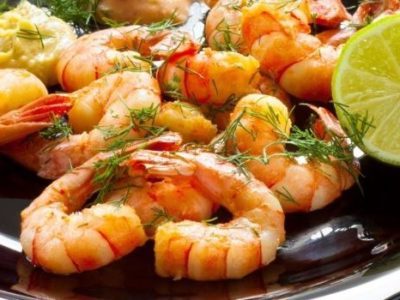

Tomatoes with cheese and garlic
A quick, tasty and simple snack that perfectly combines all the ingredients.
Ingredients:
- Mayonnaise to taste;
- Cheese - 100 grams;
- Garlic - 2 cloves;
- Tomatoes - 2 pieces.
Cooking tomatoes:
My tomatoes and cut into slices. Three cheese, pass the garlic through the garlic. Add mayonnaise and mix thoroughly with cheese and garlic. Put the resulting mixture on tomato circles, decorate with herbs and serve. Bon Appetit.


Beetroot with garlic and mayonnaise
Despite the fact that beetroot salad with garlic is the simplest of all beetroot salads, this does not affect its excellent taste. Try to cook it and see for yourself.
Ingredients:
- Beets - 2 pieces;
- Garlic - 2 cloves;
- Mayonnaise - 5 tablespoons;
- Salt and pepper to taste.
Cooking beet salad:
We take the beets, wash them and boil them. When it cools down, rub it on a fine grater. Add garlic, passed through the garlic, salt and pepper to it. We mix.
Add mayonnaise, mix and refrigerate for two hours. Serve when the salad is infused. Bon Appetit.
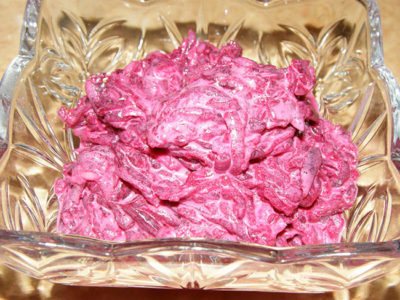

Eggplant rolls with cheese and garlic
A popular in Eastern countries appetizer made of fried eggplant and spicy cheese and garlic filling will not leave you indifferent.
Ingredients:
- Eggplant - 3 pieces;
- Lettuce leaves - 2 pieces;
- Dill, cilantro, basil - 4 sprigs each;
- Sunflower oil - 0.5 cups;
- Cheese - 100 grams;
- Mayonnaise to taste;
- Garlic - 3 cloves.
Cooking eggplant rolls:
We take eggplants, cut them into longitudinal plates, 3 mm thick. Soak in salt water for half an hour. Then fry in oil on both sides.
We take cheese, grate it three times, mix with mayonnaise and garlic, passed through a garlic clove. Chop the greens and add to the mixture. We mix.
On each eggplant plate, lay out the filling and roll it up. Cool the rolls and serve on lettuce leaves. Bon Appetit.
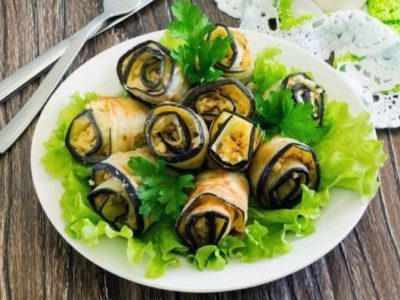

Pampushki with garlic
Fragrant yeast buns go well with soups and borscht. But most often, they are eaten while still warm.
Ingredients for the dough:
- Dry yeast - 11 grams;
- Warm milk - 200 milliliters;
- Flour - 500 grams;
- Sunflower oil - 3 tbsp spoons;
- Sugar - 2 tbsp. spoons;
- Salt - 1 tsp.
- To grease buns:
- Cream - 1 tbsp. the spoon.
Ingredients for the sauce:
- Vegetable oil - 1 tbsp. the spoon;
- Garlic - 3 cloves;
- Water - 2 tbsp. spoons.
Making garlic buns:
From all the above ingredients for buns, prepare a yeast dough. Then we divide it into 12 parts, roll them into koloboks and put them on a greased baking sheet. Leave the buns for 30 minutes, then grease them with cream and set them to bake in the oven for 25 minutes at 180 degrees.
For the sauce, take the garlic, pass it through the garlic clove and mix with water and oil.
After the time has elapsed, remove the buns from the oven, pour over the garlic sauce and bake for another three minutes. Ready-made donuts are served to the table. Bon Appetit.
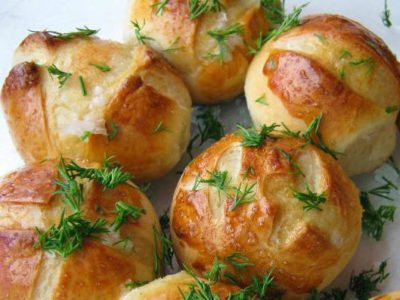

Preparation of soil and planting material
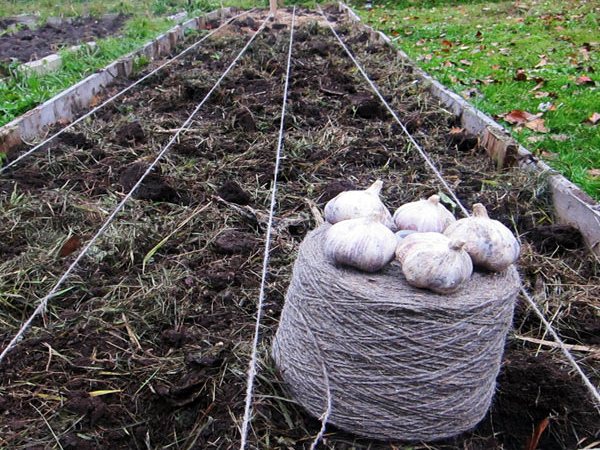

The soil on the site for planting garlic should be warmed up (the optimal time is mid-April). The garden bed is dug up, loosened, all the weeds are dug out and watered with a solution of salt (3 tablespoons per bucket of water). The soil will be ready for planting in 2 days.
Best and worst predecessors
It is strictly forbidden to plant spring garlic after tomatoes, carrots, potatoes and onions. It is possible to grow it on the site after onions and garlic only after 3-4 years. The best precursors for garlic will be cucumbers, cabbage, squash, zucchini, legumes and grains, and herbs.
Garlic can be beneficial in the neighborhood of tulips, roses, gladioli, gooseberries, black currants, potatoes, cucumbers, as it repels weevils, slugs, borers and other pests. Garlic oppresses peas, beans and cabbage.
Processing cloves before planting
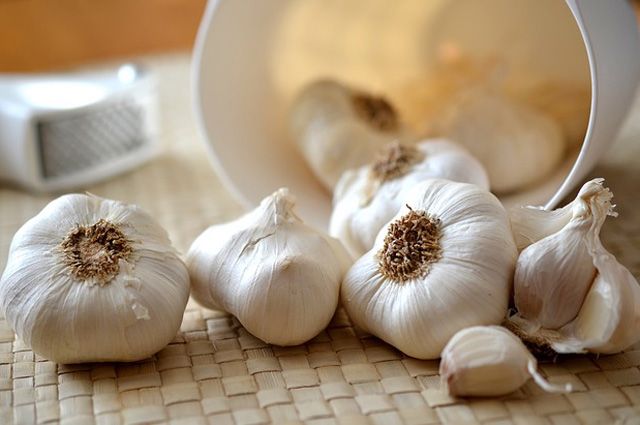

It is recommended to start preparing for planting garlic in spring in autumn. The harvested planting material tolerates moderate cold well. For storage, it is placed in white bags and buried in the ground to a depth of about 50 centimeters. Having insulated with a layer of foliage and a film, you can not worry about the safety of garlic under such a "fur coat" in any frost.
Vegetative propagation is characteristic of garlic. Winter garlic can be grown from the bulbs. Spring varieties reproduce only by teeth, which are buds with a growth point and leaf buds. Before buying garlic for planting in specialized stores or via the Internet, experienced gardeners recommend studying zoned varieties that guarantee good ripeness and high yields in a particular region.
For growing spring garlic in the garden, choose whole, firm, large and medium-sized cloves weighing from 3 to 6 grams or more. Immediately before planting, they are separated from the bulb, without removing the scales. Experienced vegetable growers do not recommend taking cloves from an onion, on which there are only 2-3, for planting. This is an unsuitable for propagation, degenerating garlic.
Self-grown seed garlic is sorted before planting: large teeth are used for the main planting and further storage, and small ones are planted between rows of carrots to scare away carrot flies or between bushes of early potatoes in order to reduce the population of the Colorado potato beetle. This garlic is suitable for summer use and preservation.
Wrapped in a towel moistened with water, the teeth are placed in the refrigerator for several days. 12 hours before planting, it is recommended to decontaminate them in a 1% solution of copper sulfate or potassium permanganate. For this purpose, ash liquor can also be used, for the preparation of which 400 grams of wood ash is poured with 2 liters of water, boiled for half an hour, then the planting material is soaked in the resulting broth for 2 hours.
To speed up germination, some vegetable growers practice heating the planting material for 8-10 hours in warm water (40-42 ° C). To accelerate the germination of cloves in the soil, you can first germinate them at home by wrapping the garlic cloves in a damp cloth and putting them in a plastic bag for 2-3 days.
Landing dates
The crop in question must be planted only in spring, but this should not be done for the winter, since it will not be able to tolerate frost, unlike winter.
Planting is carried out in open ground in late April or early May. Do this only after there is no chance of frost. The optimal temperature regime is 5-6 degrees during the day.
How to plant
The process of planting spring garlic is simple, but quite responsible. Only with strict adherence to all the rules and recommendations can you get a high yield.
Soil preparation
It is necessary to carry out preparatory measures from the fall. It is during this period that top dressing will have to be made.
But its quantity and composition will be determined by the type of soil in the garden:
- If the soil is loamy, then for 1 m2 there are 3-4 kg of humus, 10 g of urea and 40 g of superphosphate.
- If the earth is clay, then 1 m2 accounts for 5-6 kg of humus, 5-6 g of peat, 8-10 kg of sand, 40 g of superphosphate and 10 g of urea.
- If the soil is sandy loam, then per 1 m2 add a mixture of humus in a ratio of 1: 2, and superphosphate and urea in a ratio of 3: 1.
- If the soil is peat, then 6 kg of humus, 8-10 kg of sand, 10 g of urea and 40 g of superphosphate are applied per 1 m2.
After the top dressing has been made, dig up the garden, level it with a rake and leave it for the winter. The best spring crop grows on loamy and sandy soil.
Seat selection
When choosing a site, you must take into account the amount of the crop that you plan to harvest.If the garlic will be grown as greens, then it is better to choose shady areas for it. Then the green leaves will be juicy and soft, which is great for delicious and healthy salads. And if the garlic is grown to obtain the bulbous part, then preference is given to open areas that are located under sunlight. But how winter garlic is planted, and how to do it yourself, is indicated here.
The video shows the choice of a landing site:
Crop rotation has yet to be taken into account. This has a big impact on the fall harvest. According to the rules of crop rotation, a spring crop can give a high yield if it is planted after vegetable plants such as tomatoes, cabbage, and potatoes.
Preparation of planting material
It is necessary to prepare spring garlic in the spring. There is nothing complicated in this, you just need to perform a number of simple manipulations. Seed material can be purchased, but it is best to use selected garlic from the previous harvest. For planting in the soil, select large seed material, and on the day of planting, divide them into separate elements. You should not do this in advance, since the bottom of the clove dries quickly, which can adversely affect the yield of the vegetable. With prolonged storage of already disassembled garlic, its germination decreases, and in some cases it is simply absent.
To obtain a bountiful harvest, you need to pick large, whole and non-doubled teeth. But planting material of small or medium size is perfect for growing greenery. It can be planted between the rows of other crops, because garlic is an excellent prevention against diseases and pests.
In the video - preparation for landing:
Before planting garlic, it is necessary to soak the planting material. Thus, it will allow it to be disinfected. But pecking sprouts from the cloves before planting is not a mandatory manipulation.
To soak garlic, you can use the following formulations:
- Potassium permanganate... To do this, prepare a slightly pink solution, lower the teeth and keep there for half an hour. Then remove them and send them to the ground. You can, of course, wrap their cheesecloth for a day so that the sprouts germinate. But this is optional.


Potassium permanganate - Copper sulfate. A 1% solution is suitable for this. Keep the seed in it for no more than 1 minute. Before that, you can rinse it in a salt solution, and then place it in a solution for disinfection. Before planting in the garden, the seed is not washed.


Copper sulfate - Alkaline solution... This method can be used when none of the above is available. To prepare it, you will have to use 400 g of ash, 2 water. Boil for half an hour, cool, filter and place inoculum. Keep it in the solution for 1.5-2 hours. Before planting, rinse the cloves with water and send them to the soil.
What are the dates for planting leeks, and how to plant it correctly, this information will help you understand.
But is it possible to plant onions after onions, and how to do it correctly, is indicated here.
It will also be useful to understand how the onion sets are taken care of in the open field:
But how to plant onion sets Stuttgarter Riesen in the spring, and how to carry out all the work on your own, is described in this article.
What soil is needed for garlic
Garlic grows well on fertile loose light sandy loam or loamy soil, in non-flooded areas, with sufficient sunlight; tree-shaded areas are not suitable for this crop. It does not tolerate either excessive moisture or prolonged drying out of the soil.
It is good if the bed is located on a sunny hillock and is protected from the wind by a fence, trees or shrubs. In the spring, water should not stagnate there.
Before planting, the soil is dug up, loosened, the roots of perennial weeds are selected and carefully leveled.
When digging, humus (1-2 buckets) and wood ash (2-4 kg) are added per 1 m2. Instead of ash, you can take superphosphate and potassium salt (15-20 g each).
The acidic soil is limed. The garden bed is prepared two weeks before planting, as it should settle a little so that the garlic cloves do not go deep into the ground.
General information
The homeland of garlic is considered to be Central Asia, where they began to domesticate it. Wild garlic grows in the Tien Shan mountains and Turkmenistan.
The plant is appreciated for its medicinal properties, ability to strengthen immunity and improve digestion. In ancient Egypt, it was used as an antidote for severe poisoning and as a prophylaxis for dangerous ailments. In Rome, it was used as a spice, adding to many dishes.
The first information about garlic appeared more than three thousand years ago, it is still popular, not only because of its excellent taste, but also because of its ease of cultivation.
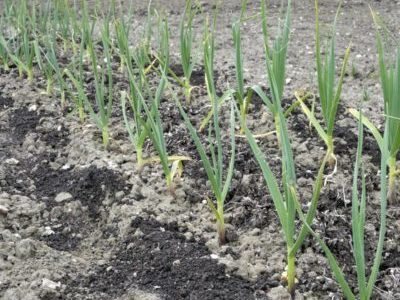

The nuances of getting a good harvest
In order for the summer resident to be satisfied with the harvest he has received, he should know about several subtleties that make it possible to achieve such indicators. One of the most important factors in increasing yields is finding the right variety of garlic. This is due to the fact that bulbs require temperatures in excess of 21 degrees to form, and 25 degrees to ripen. In some regions, such ambient temperatures are rare, so you should immediately select varieties that ripen at lower temperatures. Also, under such conditions, it is required to use a fertilizer that stimulates growth.
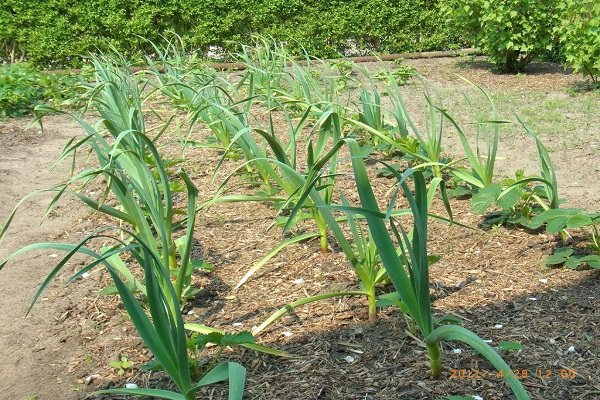

If the heat in the region does not last long, it is possible to activate the ripening process of the culture if in mid-August the bulbs are slightly removed from the soil or some of the roots are cut off. Such manipulation will provoke a violation of the function of the roots, slow down growth, the culture will direct all its forces to the formation and maturation of the bulb. Garlic leaves can be tied in knots to speed up ripening.
When do you need to knit garlic arrows in a knot? It is recommended to do this manipulation with spring garlic in mid-August.
Many summer residents say: I renew the garlic every year. This means that the bulbs of the new crop should be used for planting next year. In this case, they should be planted in a different place. You can return to the previous garden bed in 5 years.
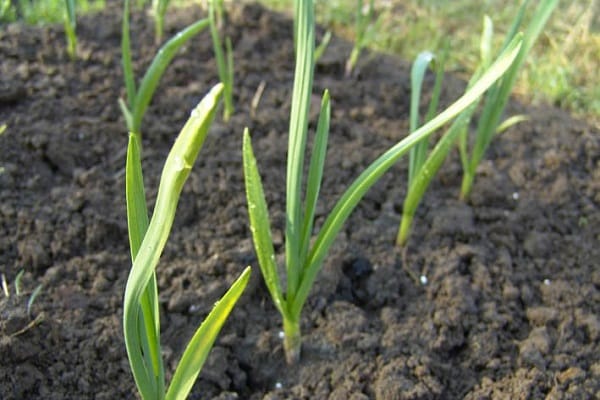

How to harvest correctly
- When to harvest
The signal for harvesting is the drying of the lower leaves or their yellowing and lodging. The harvesting period is in the first half of September. Even with early planting, in unfavorable weather during the growing season, the garlic may not have time to ripen. To speed up the ripening process, the following measures are used:
- undermine the bulbs without pulling them completely out of the ground;
- tie the leaves in a knot.
- How to do it right
The roots of the plant firmly fix it in the soil, so the garlic should be dug in during harvesting so as not to tear the leaves off the head. The dug garlic is set aside for airing in the garden for an hour or two, then the earth is shaken off and laid out to dry in a ventilated dry room. You can hang garlic tied in bunches in the attic, shed.
Caution! Drying garlic under the scorching rays of the sun is not allowed. Burns will significantly worsen the safety of the crop.
It is necessary to avoid mechanical damage and the integrity of the covering scales, through which the infestation of the bulbs occurs. After drying, cut the roots and leaves at a height of at least 5 cm above the top of the head. When weaving into braids, the leaves are not trimmed. For storage, use paper, linen containers, wooden containers with holes for ventilation. For cold storage, the temperature should be + 1-5 ° C.
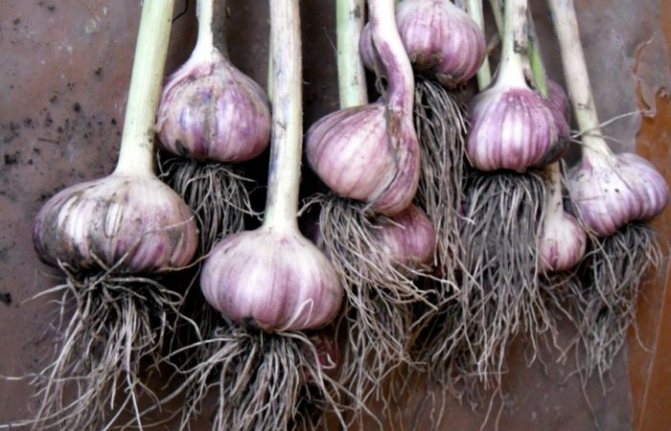

Crop rotation rules
So that winter garlic does not get sick and gives high yields, consider the rules of crop rotation:
- The best predecessors are siderates.It is recommended to plant garlic after beans, oats, buckwheat, alfalfa, clover, mustard, legumes. Of the vegetables, cabbage, early potatoes, tomatoes, beets, peppers, and carrots are considered favorable predecessors. Areas where pumpkin crops grew are considered favorable for growth.
- Unfavorable predecessors are considered crops from the onion family, suffering from the same diseases as winter garlic. These, in addition to onions and garlic, also include bulbous flowers.

